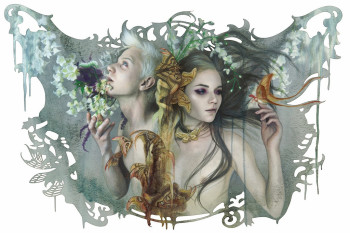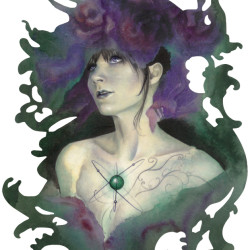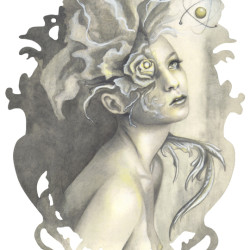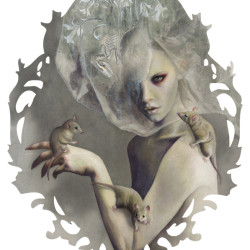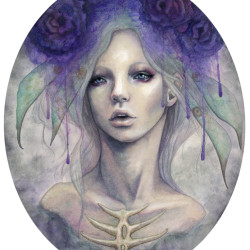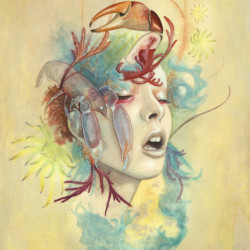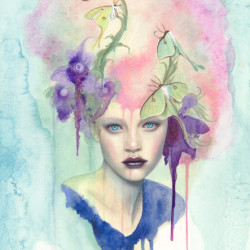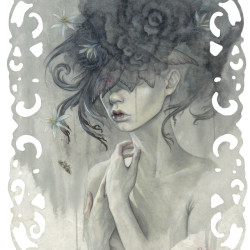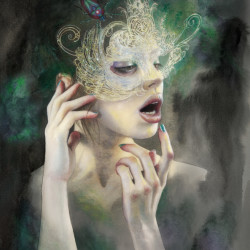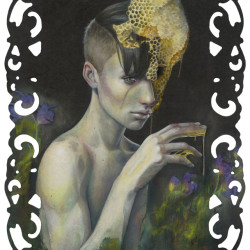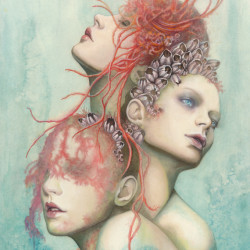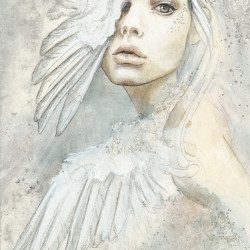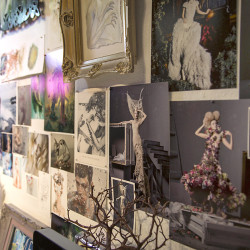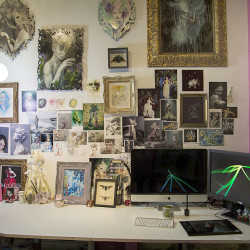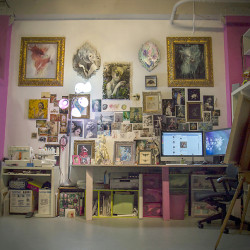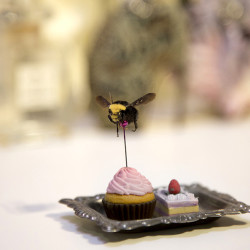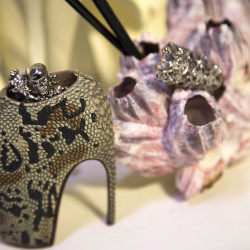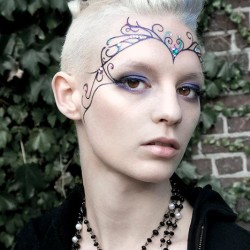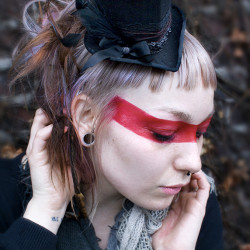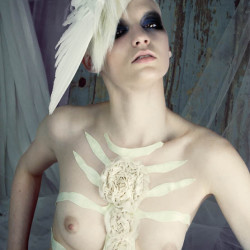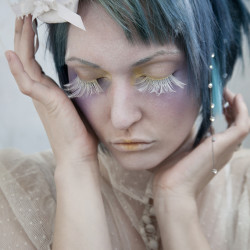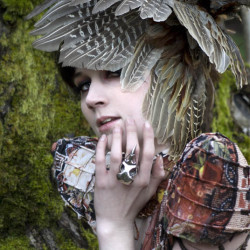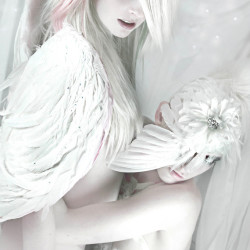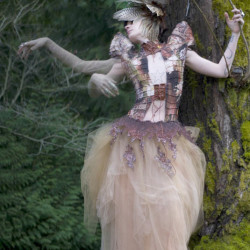In her paintings, Redd Walitzki focuses on the balance between the inevitable entropy of nature, and the unattainable beauty invented through high fashion and technology. In her work, she brings to life a compelling world of haunting, fleeting beauty. Her creations are an equal mixture of the breathtaking, the ethereal, uncanny and unsettling.
Redd Walitzki is a working artist from Germany, now living in Pioneer Square (Seattle’s artist district). She graduated from Cornish College of the Arts with her BFA in 2007 with a concentration in Painting, Video Animation and Printmaking. Redd spent several years running a studio-gallery in Seattle’s 619 Western renegade arts building, helping keep the underground art scene alive. These days, Redd can usually be found in her studio painting to BBC Documentaries, playing with her pet opossum, or chasing down the next strange adventure.
She is fascinated with flawless female forms and detailed natural elements, which she combines to create a daydream of lovely aberrations. Redd pushes herself through her use of materials as well, creating a multilayered process that includes elements of watercolor, acrylic layering, digital flourishes, rice-paper transfers and oil glazes. Her delicate swirling panels evoke themes of neoteny, the desire for perfection, and the fine line between the abject and beautiful.
Interview with Redd Walitzki conducted by MIROIR Magazine’s Chloe Allred.
Q: We’re interested to hear about your basic inspirations that drive your creative energies.
A: My main inspirations have always come from fashion, nature and biology. Visually, the surreal world of fashion editorials and couture runways has always had huge appeal to me. I love the fantasy of fashion, how moments that are impossibly beautiful can be staged and created to transcend the mundane reality of everyday life. This is something I really hope to achieve in my work as well. Biology and nature are also extremely inspiring for me, and usually when I’m painting I listen to BBC Science Documentaries in the background. I collect different natural specimens, from insects and dried feathers, to bones and cool looking pieces of moss. One of my favorite designers & heroes, Alexander McQueen, said of his work, “It needs to connect with the earth. Things that are processed and reprocessed lose their substance.” That’s been really true for me – usually organic shapes are so much more complex and amazing than man-made or geometric shapes. So while I love things like glam rock and sci-fi, my artwork is often more influenced by biological forms and ornate textures. There is so much beauty in the variety of strange and wonderful creatures and forms evolution has come up with, and its so interesting to draw inspiration from them. I also adore Baroque and Art Nouveau design, so a lot of those swirling lines and curves have a big influence on me as well.
Q: How do you feel that creating your “art” is a part of your lifestyle, and life’s plan for you?
A: Its always felt like I had no other choice – while there are other activities I enjoy, art has always been like breathing to me. If I have to listen to a lecture, or wait at a bus stop, eventually I start doodling. If I haven’t made anything for longer than a week, I start feeling unbalanced (even on trips, after a few days of relaxing I usually start some random project). So its never really been a matter of “art or not art?”, but more of “what kind of art?”. At this point, my lifestyle really revolves around my art – the main space in the studio I live in is my workspace. I also work part-time at an amazing Fine Art Scanning and Printing Studio (Bellevue Fine Art Reproduction) which keeps me connected to a lot of the local art community, and supports my studio practice really symbiotically. For many years I even lived in an artist collective warehouse with no kitchens and shared bathrooms, just so artmaking would be the most central part of my day. But this focus is what makes me happiest, and it’s given me amazing opportunities to be constantly surrounded by other artists. I feel very lucky that my life so far has been the way it has.
Q: Where is the source of your creative inspiration, initially, and how has it been nurtured throughout your creative endeavors? Where does your creative process begin? Where do you get your ideas?
A: Inspiration can come from so many directions, and I try to constantly feed myself tons of new ideas to keep fueling my creativity. I read a lot, and vary from reading literature and fantasy, to philosophy and art-theory. My favorite books are really complicated and dreamlike, like the works of Haruki Murakami or Mark Z Danielewski. I always get really inspired while I’m reading something psychological and poetically complex. Often the idea for a painting will spring from a phrase, a short sentence, a lyric. In my studio, I’ve also made it a practice to have an “inspiration wall” by my workspace, so I can keep visual ideas and color palette inspirations in front of me while I work. Its full of fashion photos I admire, work by other artists that inspires me, and interesting textures or bits of dried plants, feathers, insect shadowboxes, anything that I find fascinating at the time. This has helped strengthen my work a lot, because it constantly reminds me of the directions I want to go, and the way I want my work to function. At this point, the space is almost growing itself – its becoming a little world for me to sit in and find interesting ideas. While I paint, I usually listen to documentaries and audio books, mostly on science and history topics that interest me. Often this gives me the next idea for a painting, bits and pieces float around in my subconscious until they find their way into my work. I’m often drawn to things that are beautiful, but have an edge to them; things that could be considered abject or unsettling, yet have a visual beauty to them.
Q: Tell me something about your history in the creative arts. What led you to Seattle and to ultimately attending Cornish?
A: I was born and grew up in Germany, and then my family moved to Oregon when I was in elementary school. While Portland was too small for my taste, I do like the being in the Pacific Northwest. After spending a year studying in New York, it seemed like Seattle would be a great city to start out in, so I transferred to Cornish College of the Arts. I liked the innovative approach Cornish has to teaching art – many other schools focus heavily on technique, but Cornish focuses much more on discovering who you are as an artist, and how to draw the concepts that are significant to you out of your work. Technique is something I push myself on anyways, but it was hugely influential for me to really stretch the boundaries of what matters to me as an artist, and start seeing everything I make as a connected body of work.
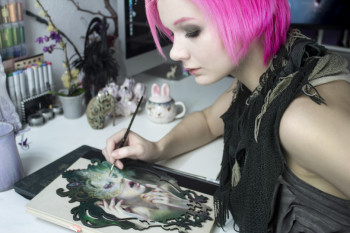 Q: What were the circumstances that planted that first creative spark in you, and how is that tied to your current inspirations?
Q: What were the circumstances that planted that first creative spark in you, and how is that tied to your current inspirations?
A: I’ve been drawing and making things for as long as I can remember, even in most of the photos of me as a young child I’m scrawling with crayons or crafting something. But in high school I had that moment where I realized that art is the most important thing for me to be doing, and what I wanted to do for the rest of my life. I’ve always been very drawn to beautiful things, and I always wanted the power to create beauty and share it with others. For me the process of making my art is often about trying to reach my ideal of beauty.
Q: I know that your sister is a skilled musician–how have the two of you collaborated?
A: It’s been really inspiring to collaborate with Roxanna, because so often the arts are very removed from each other, and getting a whole new influence from classical music helps me think about things in a new way. She’s also amazing for me to work with, because we are equally passionate about what we do, and always want to make the best product we possibly can. There’s a natural ease to the way we can work together, probably because we know each other so well, but she also always surprises me with what she comes up with, which is exciting!
Q: Your boyfriend, Carl Faulkner, is also an excellent painter. Do the two of you collaborate and how do you influence one another?
A: Carl and I met at Cornish, and its been amazing and wonderful to find my voice while having a supportive partner that gets where I’m coming from and how important art is to me. He’s a great sounding board for new ideas, and often our various obsessions and tangents definitely influence the other one. Carl’s work is different from mine, and sometimes the challenges we face are different, but it’s great to look up from painting for an evening to see him working on something on the other side of the room. We have collaborated a lot too, and often that’s where I get the best ideas of where I want to go with my own work. After graduating art-school we also ran X17, a studio/gallery, together for 4 years, and especially as a curatorial team we work really well together.
Q: What is a typical day like for you?
A: I’m a night owl, so I usually wake up pretty late in the day, drink some coffee, run some errands, and then start painting in the early evening. Until late into the night I’m either painting or working on projects on my computer (editing reference photos, etc). Throw in some candy, bacon & caffeine and you’ve got a pretty typical day!
Q: How has living in Seattle influenced your work?
A: I don’t really fit in with the “Seattle Aesthetic” which is usually more grunge, or more NW type materials like wood and stone and glass. Maybe I make such light, ethereal, fashion-related work because there isn’t much of that here, and it makes me crave it more. But Seattle is a gorgeous city, and living right by the water and around the lush green landscape has probably pushed me in a more organic direction than before I lived here. There are elements of Germany, Seattle and all the places I’ve lived in my work – where we are always shapes us!
Q: What is the power of your medium, and message, for you? Why specifically painting?
A: Painting gives me the chance to invent an entirely new and controlled world, with only the elements I feel like including. Playing with photography or video is fun, but there are always too many elements I can’t fully control for me to be totally satisfied with the end product. It’s also the physical qualities of the medium – I love working on my computer, but there’s just something about paint on a surface that’s so direct and lovely. My favorite media to work in are watercolor and oils, and my current process combines the best of both. I love watercolor for its spontaneity; when I’m working on a watercolor there is an element of surprise to what the paint will do. Often those textures are my favorite parts of the piece. Oils are so rich and stunning, especially glaze-layers have a brilliance of color that just isn’t equaled by anything else. I’ve been accused of being a mad scientist before, often I have weird little paint experiments and texture swatches going somewhere on my desk. Lately I’ve been starting with a watercolor, scanning it and printing it on ricepaper, transferring that to woodpanel, sealing it with various acrylic coatings and then finishing the piece in oil glazes. We have so much access to exciting new-media processes these days that I love trying to find ways to use them in my workflow.
Q: How important is audience to you?
A: I love having a direct relationship with my audience, and especially with the internet it’s become much easier to have that instant feedback and connection, which is really encouraging. But really, I make my work for me – and I feel happy and lucky when its a wavelength other people can get on and enjoy. I do have a stubborn streak, and it’s really difficult for me to make something I don’t feel a connection to. But so far just making exactly what I want to and then hoping others will get it has been working pretty well…
Q: How does personal intuition play a part in your life’s work?
A: My intuition is definitely my guiding star – often I feel like I need to keep honing my skills and practicing techniques, but I almost always know instinctively if something has the correct feeling. Usually I have a vision that I’m striving for, and it’s a matter of pushing myself to live up to my plans and taste. But sometimes it’s also great to let a little bit of chaos enter the process, its easy to become too much of a perfectionist, so adding elements I can’t control like drips or weird mediums helps keep me more grounded.
Q: What are some of your upcoming projects?
A: I’m in an awesome show in May at Modern Eden Gallery in San Francisco about “The Language of Flowers.” In April and May I also have a solo show in Ballard at the Balmar, which is mostly work from the last year and most of it has never been shown in Seattle, so it will be nice to have it on the home turf. I’m also going to be showing with Auguste Clown Gallery in Australia later this year, and I have a really exciting collaboration with a musician I really admire in the works that’s still secret for now.
Q: What is your idea of success?
A: Recently, I was at the SAM (Seattle Art Museum) and while wandering through their permanent collection, I noticed there was a small crowd gathered in front of a little Dutch still-life. It wasn’t an especially famous piece, but it was the most beautiful thing in the room, and compared to everything else there it had a magnetism that made people gather and look at it in particular. I want to be making the kind of work that has that power – work that lasts longer than I do, but also remains relevant and beautiful to people.
Q: What makes you happiest?
A: When a painting is going well. When inspiration is bubbling over and I feel like I can’t get the ideas down fast enough. When it’s sunny outside and I have free time to frolic. When I get to explore beautiful new places. When I’m surrounded by people that inspire, amaze, fuel and understand me. That’s when I’m happiest!
Q: What is your moment of perfection?
A: A moment in the presence of beauty – whether I’m finding, experiencing or creating it.
© 2013 MIROIR Magazine interview by Chloe Allred
MIROIR Magazine presents a selection of photographs by Redd Walitzki
Links and credits:
Redd Walitzki’s website
Redd Walitzki – When We Break
Redd Walitzki – Vergissmeinnicht
Interview with Redd’s sister Roxanna Walitzki
MIROIR Magazine’s featured portfolio of the art by Redd Walitzki is available in print through the link below.
By MIROIR Magazine in MIROIR MAGAZINE • “Primavera” Collection
172 pages, published 4/10/2013



